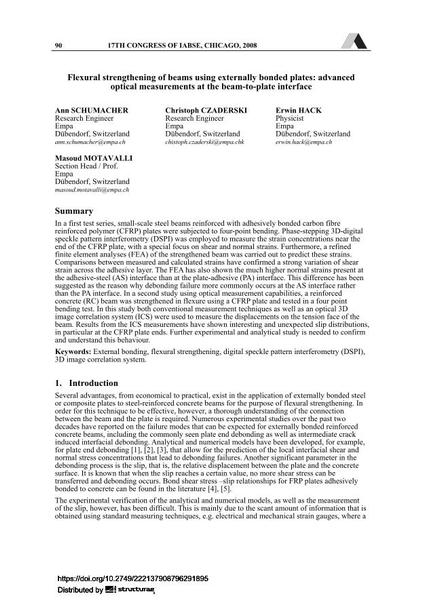Flexural strengthening of beams using externally bonded plates: advanced optical measurements at the beam-to-plate interface

|
|
|||||||||||
Détails bibliographiques
| Auteur(s): |
Ann Schumacher
|
||||
|---|---|---|---|---|---|
| Médium: | papier de conférence | ||||
| Langue(s): | anglais | ||||
| Conférence: | 17th IABSE Congress: Creating and Renewing Urban Structures – Tall Buildings, Bridges and Infrastructure, Chicago, USA, 17-19 September 2008 | ||||
| Publié dans: | IABSE Congress Chicago 2008 | ||||
|
|||||
| Page(s): | 90-91 | ||||
| Nombre total de pages (du PDF): | 9 | ||||
| Année: | 2008 | ||||
| DOI: | 10.2749/222137908796291895 | ||||
| Abstrait: |
In a first test series, small-scale steel beams reinforced with adhesively bonded carbon fibre reinforced polymer (CFRP) plates were subjected to four-point bending. Phase-stepping 3D-digital speckle pattern interferometry (DSPI) was employed to measure the strain concentrations near the end of the CFRP plate, with a special focus on shear and normal strains. Furthermore, a refined finite element analyses (FEA) of the strengthened beam was carried out to predict these strains. Comparisons between measured and calculated strains have confirmed a strong variation of shear strain across the adhesive layer. The FEA has also shown the much higher normal strains present at the adhesive-steel (AS) interface than at the plate-adhesive (PA) interface. This difference has been suggested as the reason why debonding failure more commonly occurs at the AS interface rather than the PA interface. In a second study using optical measurement capabilities, a reinforced concrete (RC) beam was strengthened in flexure using a CFRP plate and tested in a four point bending test. In this study both conventional measurement techniques as well as an optical 3D image correlation system (ICS) were used to measure the displacements at the tension face of the beam. Results from the ICS measurements have shown interesting and unexpected slip distributions, in particular at the CFRP plate ends. Further experimental and analytical study is needed to confirm and understand this behaviour. |
||||
